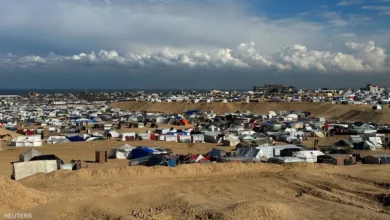Al-Qaeda and ISIS in Africa between dissonance and convergence

Department of African Research and Studies
20/04/2021
Writers: Sabreen Al-Ajroudi, Hadi Al-Hadef
Revised by: Dr. Badra Gaaloul
Translator: Wiem Sayari
The areas of influence of ISIS and Al-Qaeda in Africa
After the multiple defeats of the armed terrorist groups in the Asian region, especially in Iraq and Syria, their ambitions turned to the African continent. The latter has become the appropriate place to reunite their diaspora. ISIS and Al-Qaeda struggle over reunification and the extension of their influence in all parts of the world and across the continent. They took advantage of the instability of the security and political situation in various African countries, in particular after the inauguration of Abu Obeida Youssef al-Annabi as the new leader of al-Qaeda in November 2020.He succeed Abdelmalek Droukdel, who was killed in July 2020 in Mali.
In the North African region, specifically in the Maghreb countries, ISIS is working on establishing an emirate in North Africa through the Libyan gate. ISIS terrorists tried to situate themselves in the city of Derna, 1,300 km east of Tripoli, for the sake of establishing a recruitment center. However, they met an impenetrable armed response from a terrorist group loyal to al-Qaeda called Ansar Al -Sharia , which made ISIS retreat and turn to the city of Sirte to relocate itself.
The hypothesis concerning the extension of ISIS in Libya has become weak, because it will be involved in military confrontations from all sides. It faces the forces of “Fajr Libya” in the west, the forces of the Libyan army in the east and Al-Qaeda in the south. However, this did not prevent ISIS from targeting soldiers and military equipments belonging to the Libyan army forces in Benghazi.
In Tunisia, we find the Uqba Ibn al-Nafi Brigade. It is a splinter from Al-Qaeda in the Islamic Maghreb, which pledged allegiance to ISIS and is still targeting the Tunisian National Army forces in Chaambi Mountains. This group claimed terrorist attacks that took place in Bardo and Sousse in 2014. We also mention the new ISIS branch , called Jund al-Khilafa. It is located in Djebal al-Mghila in Sidi Bouzid, the northwestern heights of El Kef and the Jendouba forests.
Perhaps the Uqba Ibn Nafi Brigade, located in the west of Tunisia, pledged allegiance to ISIS, may represent a painful blow to al-Qaeda. It also shows disunity, distrust and disloyalty.
The Egyptian researcher specializing in Libyan affairs, Abdel-Sattar Hatita confirms that ISIS and Al-Qaeda have currently agreed on armed and logistical cooperation represented in food, ammunition and car fuel, for the sake of targeting the Libyan army with the support of Turkey, that stands with the Libyan Government of National Accord.This is an evidence that all terrorist groups have one reference and they meet when reality imposes itself upon them. They especially meet when they are in danger, so the enemy becomes one, the war is one and the goal is one.
In Algeria, there are many terrorist organizations, especially in the regions of Bouira and Skikda. They are loyal to al-Qaeda, and this is what we know through the refusal of the Uqba Ibn Nafi Brigade in Algeria to pledge allegiance to ISIS. The active terrorist groups in Algeria are numerous, including the Brigades of The Signers of Blood, Jund al-Khilafa and the Movement for Oneness and Jihad. The latter is still operating in secret.
In Morroco, many attempts to recruit young people under the banner of Jund Al-Khilafa through social media were aborted. The Moroccan authorities succeeded in arresting the Algerian terrorist Hussein Dahous, who tried to attract some young people to join the organization.
Al-Qaeda is rooted in Mauritania and has incubators and popularity. It also committed many massacres and terrorist operations. Mauritania suffers from the presence of al-Qaeda and its operations as well as its moving cells from time to time. Therefore, the G5 Sahel chose Nouakchott to be its official headquarter.
In Egypt, ISIS and Al-Qaeda are working together. Despite the serious efforts that Egypt made to settle the problem of terrorism, especially in Sinai, Terrorist groups are still holed up in many areas of it. This does not mean that Egypt has thwarted the attempts of the so-called Ansar Beit Al-Maqdis organization .The latter is a pro-ISIS group, which includes about 5,000 fighters, and has committed nearly 50 armed attacks on Sinai.
The influence of these two organizations varies in West Africa and sub-Saharan Africa. Mali suffers from the Al-Mourabitoun organization, a terrorist group affiliated with Al-Qaeda, which operates in northern Mali and from Al-Mulathameen Brigade (Brigade of the Masked Ones) .The latter has splintered from Al-Mourabitoun organization, that also pledged allegiance to ISIS. The two organizations jointly targeted the French army forces in Mali, which succeeded in eliminating the leader of Al-Qaeda in Africa, Abdelmalek Droukdel in July 2020. Al-Qaeda is imposing its presence in Niger and Chad and trying to re-establish its influence.
In Nigeria, West Africa, Abu Bakr Shekau leads the Boko Haram organization. It pledged allegiance to the Islamic State and targets civilians and regular forces.It also controls 20% of Nigeria and competes with the Al-Qaeda-affiliated Ahl al-Sunnah Group for Preaching and Jihad.
For the eastern coast of Africa, Al-Shabaab Al-Mujahideen organization operates in Somalia. It splintered from Al-Qaeda and pledged allegiance to ISIS in 2014.It is one of the most powerful armed terrorist groups in the region. Sudan also is still suffering from the attacks of terrorist movements centered in Darfur, suspected of being linked to Al-Qaeda.
The Ugandan Muslim Liberation Army is considered one of the most powerful armed terrorist organizations situated in the center of the continent. It is based in the Rwenzori mountain range and pledged allegiance to ISIS in 2015.
South Africa recorded only the presence of small and scattered terrorist groups loyal to ISIS. The percentage of influence of each of the two organizations varies according to the region and according to the social awareness of people.
Ideological differences between al-Qaeda and ISIS
Many political analysts stated that the divisions that Al-Qaeda experienced and the birth of a new terrorist group under the name of the Islamic State in Iraq and Syria (ISIS) are mainly due to ideological and institutional differences between the elements of Al-Qaeda.
Despite the total number of battles that the two organizations fought in order to spread Islam and protect Muslims (from their point of view), the ideological background of each one of them clearly differs. For that reason, it is necessary to unveil the differences between Al-Qaeda and ISIS.
A 52-minute video clip published by ISIS under the title “Deviations of Al-Qaeda” represented the first spark that suggested the difference between the ideology of ISIS and the jihadist approaches adopted by Al-Qaeda. Thomas Joslin, a member of the Foundation for Defense of Democracies described it as «an open institutional hatred towards Al-Qaeda.”
Al-Qaeda considers war necessary before spreading and establishing the Islamic religion and swearing allegiance to a caliph, while ISIS considers it necessary to pledge allegiance to a caliph of Muslims who leads jihadist operations to spread Islam throughout the world.
The journalist and political analyst Muhammad Barkani mentioned that Al-Qaeda approach is similar to the Trotskyist method and it is less severe than “the Stalinist approach” adopted by ISIS.
Al-Qaeda‘s main goal is not to occupy lands or to expand into areas and isolate them, but rather allows dealing with a population, other groups and even states. On the opposite, ISIS wants to imitate the state by establishing political, financial and judicial institutions and imposing a set of rigid laws on the population that reach the point of punishing people considered as infidel. This will result in the refusal of any deal with any foreign country.
In addition, Al-Qaeda identifies its enemies exclusively and thinks that the first way to spread Islam and defend the lands of Muslims is to get rid of the United States of America and the West, who stands as a real threat to the existence of Muslims. Therefore, the West and America must be destroyed as a precondition for the establishment of the Islamic religion. Conversely, the enemies of ISIS are many and they vary according to the historical and political context .There is no specific enemy of ISIS.A group of Muslim citizens who do not attend prayer maybe considered as enemies of this organization. The Islamic State in Iraq and Syria is hostile to everyone who differs from their approach to the extent that it committed atrocities against the Syrian regime forces (for sectarian difference), the Kurds in Iraq and Syria (for ethnic difference), and also against Christians and religious minorities such as the Druze in the Middle East (a religious difference).
The war strategy differs between these two organizations, Al-Qaeda prefers to lead insurgencies, intermittent and sudden strikes on the enemy to distract its efforts, while ISIS chooses to launch comprehensive attacks and strikes on the ground against the regular armies to weaken them in order to enter the region.
We can also note that there is a difference at the level of communication policy. Al-Qaeda aims to inform the public of its messages and discourses by publishing videos carrying long religious sermons, mostly characterized by a low degree of threat and violence in order not to alienate the local population and to win hearts and minds.
It is a communication policy that differs from ISIS, which adopts a unified communication strategy .It publishes videos of violent executions carried out by terrorists against unarmed citizens or regular soldiers that contain a threat of death and destruction of the world.
It can be said that the dissonance between Al-Qaeda and ISIS is due to significant differences at the ideological, institutional and communication level.
Competition:
A severing of relations between ISIS and Al-Qaeda started at the beginning of 2011 when the war took a foothold on the Syrian territory. This coincided with the desire of Abu Bakr al-Baghdadi to expand his activities and projects in this region at the end of 2010, specifically with the emergence of conflict and instability in Syria. He put a large number of his fighters to fight against the Syrian regime.
Al-Qaeda leader Ayman al-Zawahiri’s position ranged between acceptance at the beginning and rejection at the end, specifically due to his group in Syria, led by Syrians and independent of ISIS. The group is called the “Nusrat al-Islam Front.” Ayman al-Zawahiri clung to this branch.
ISIS held a prominent position against the policies adopted by al-Qaeda, as the latter’s programs and goals revolved mainly around the fight in Syria, while ISIS was very interested in Iraq. The differences between the two terrorist organizations led to a conflict that continued until 2013 when Al-Zawahiri ordered the leader of ISIS to comply. The latter responded by destroying the “Nusrat al-Islam Front” to operate in the Iraqi territories and divert its programs towards the region.
The end of 2014 was the beginning of the war between the two sides and after it the severing of the link between Al-Qaeda and ISIS was announced. It is worth noting that the announcement of the full designation of the “Islamic State in Iraq and Syria” (ISIS) specifically followed the break between the two organizations.
It is obvious that the goal is clear to most terrorist organizations and groups, but it is necessary to pay attention to the necessity of studying the sub-differences .These differences have value .In particular on the relationship between these organizations and the extent of their harmony or conflict .
The differences between Al-Qaeda and ISIS is clear. Their perceptions and strategies used to achieve their goals differ as well as their enemies. Al-Qaeda focuses on confronting and fighting foreign interference and foreign powers and in particular the United States of America as well as the government and bureaucrats in Syria. However, ISIS relies on harming local enemies before heading towards the external enemy. For that reason, most of the victims of ISIS are Muslims that contradicts its rituals and ideas due to its pursuit of the principle of “purifying the Muslim community”. Their aim is to liberate it from the local infidel systems that affect the Muslim public, and directs Muslims to oppose them at various levels. The ISIS ideology is based mainly on the establishment of the “caliphate”.
The strategy of ISIS seems more clashing than the one followed by Al-Qaeda. The latter did not rely on the policy of expanding its areas of influence in an Arab or an Islamic country or seeking to control an area that represents its ideology and ideas and imposing it on its residents. Its practices were limited to propaganda and promoting their thought through audio and video tapes that urges citizens to embrace their ideas.
On the opposite, The ideology of ISIS is based on owning and ruling a state of their own where people who embrace their controversial ideology live, noting that they will not stop at that limit. After creating their own space they will seek further expansion, the addition of more lands and the inclusion of a larger number of adherents to their ideology.
In addition to the struggle over influence, the battle between the two organizations seems to be based mainly on the adopted strategies. ISIS accuses al-Qaeda of weakness and deviation from the path of jihad, while al-Qaeda believes that ISIS is too bloody , especially after many secondary organizations and groups joined ISIS , which has made it stronger. In return, Al-Qaeda became weak on various levels.
Al-Qaeda was adopting an alternative plan, as it sought to present itself in a more moderate and less brutal image then ISIS. It tries to appear in the image of a more resilient organization that accepts changes for the sake of searching future opportunities. Al Qaeda is studying the current situation and the feasibility of the strategies adopted in the long term.
It can be said that Al-Qaeda will inevitably be more dangerous compared to ISIS, precisely because of the popularity it has at the local level as a result of her strategy that focuses on attacking the external parties to win the local population and enhance its legitimacy.
Al-Qaeda and ISIS in Libya:
It cannot be said that the relationship between Al-Qaeda and ISIS has an absolute competitive nature. In this regard, the Egyptian researcher specialized in Libyan affairs, Abdel-Sattar Hatita, indicated that the two organizations exchange cooperation to a higher extent within Libya, specifically in the south .They are massively located within this region due to the deterioration of the security conditions added to the fact that the site provides the appropriate conditions to attract young people as a result of the conservative cultural environment. Therefore, the south, unlike the rest of the regions, represents an incubator area for terrorists, even if the rest of the Libyan region is safe.
Geographically, the south of Libya has a logistical importance for many countries such as Russia and Turkey, the latter has an important role in the infiltration of mercenaries and terrorists from Syria to the Libyan south, so this region will remain a safe area for Turkey without entering into Egyptian skirmishes.
Researcher Abdul-Sattar Hatita also pointed out that al-Qaeda, even if it retreated from ISIS, still maintaining its strength and cohesion in many African countries such as Algeria, Mali, Niger, etc.
The cooperation between the two organizations is based on exchanging fuel for cars and food, and employing people to send messages in order to avoid censorship. Both parties also launch joint invasions in cooperation with mercenaries to obtain money.





